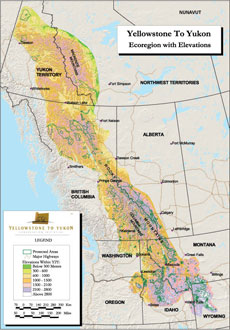|
What are wildlife corridors?
Wildlife corridors are areas of land that connect fragmented habitats. Continuous, wild habitat becomes fractured as development encroaches. While national parks and protected lands provide relatively safe havens for wildlife, they can also isolate wild populations to their detriment. Wild populations require a range of continuous habitat in order to adapt to changes in weather, food availability, and other major influences. Wildlife corridors allow populations to move from habitat to habitat. Without wildlife corridors, isolated populations are vulnerable to starvation, disease, inbreeding, and more.
There are 17 “Critical Cores and Corridors” (CCCs) identified by the Yellowstone to Yukon Conservation Initiative within the Yellowstone to Yukon region. These CCCs were chosen for protection in order to provide essential connectivity between core habitat areas. Areas identified as CCCs include the Clark Fork Corridor near Missoula, Montana, The Cabinet-Yaak Mountains in northwestern Montana and northern Idaho, and the “Northern Crown of the Continent” between the Elk Valley in B.C. and the Crowsnest Pass area in southwest Alberta.
Why is the Yellowstone to Yukon region important?
From Yellowstone National Park to the Yukon Territory, the Rocky Mountains are one of the most celebrated and beloved mountain ranges in the world. This region is the birthplace of the national park systems in both Canada and the United States, and is home to the largest collection of land-dwelling carnivores in the world. This area also constitutes a big part of our continent's remaining natural heritage, representing the last best chance on Earth to maintain a fully functioning mountain ecosystem—one with clean rivers teeming with trout and salmon, clear skies full of raptors, mountain highlands sporting abundant sheep and goats, and healthy forests plentiful with deer, bear, moose, wolf and caribou. Approached with wisdom and prudence, this region offers us vital communities, sustainable economies, and a unique quality of life.
What is the Yellowstone to Yukon Conservation Initiative?
Combining research and stewardship, the Yellowstone to Yukon Conservation Initiative (Y2Y) seeks to ensure that the world-renowned wilderness, wildlife, native plants, and natural processes of the Yellowstone to Yukon region continue to function as an interconnected web of life, capable of supporting all of its natural and human communities, for current and future generations. To realize this vision, Y2Y was officially created in 1997 by conservationists and scientists who saw a need for an organization to support and fund initiatives to increase awareness of, knowledge about, and action for the critical Y2Y region. For more information, visit www.y2y.net.
|

Photo courtesy of Yellowstone to Yukon Initiative |


